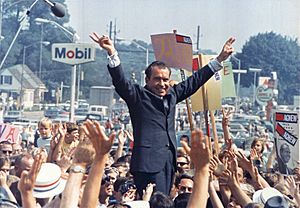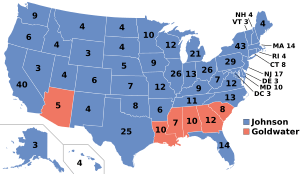Southern strategy facts for kids
The Southern strategy was a plan used by the Republican Party to gain more political support from white voters in the South. This strategy involved appealing to feelings about race, especially during the Civil Rights Movement in the 1950s and 1960s.
As the Civil Rights Movement worked to end Jim Crow laws (which enforced racial segregation), tensions grew in the South. Republican politicians like Richard Nixon and Barry Goldwater used strategies that helped many white, conservative voters in the South switch from supporting the Democratic Party to the Republican Party. This also made the Republican Party more conservative.
The term "Southern Strategy" mainly refers to how Republican leaders purposely appealed to white Southerners' concerns about race to win their votes. Experts generally agree that this focus on racial issues was a key reason for the big political change in the South after the Civil Rights Act of 1964.
Because the Republican Party was seen as supporting white supremacy in the South, especially during the campaigns of Goldwater (1964) and Nixon (1968, 1972), it became hard for the party to win back the support of black voters later on. In 2005, the chairman of the Republican National Committee, Ken Mehlman, even apologized to the National Association for the Advancement of Colored People (NAACP) for using racial differences to win elections and ignoring black voters.
Contents
How the Strategy Began

The idea of the "Southern Strategy" became well-known because of Kevin Phillips, a political expert for Nixon. In 1970, Phillips explained his ideas about how different groups of people voted.
He said that Republicans would not get many black votes, and they did not need them. He believed that the more black people registered as Democrats in the South, the more white people who disliked black people would leave the Democrats and become Republicans. Phillips saw this as a way to gain votes.
While Phillips wanted to increase Republican power by dividing voters by race in general, the South was the biggest success of his plan. It started with presidential elections. Over time, Southern voters began to elect Republicans to Congress and then to state and local offices. This happened as some older Democratic politicians, who had supported segregation, retired or switched to the Republican Party.
From 1948 to 1984, the Southern states, which had been a strong base for Democrats for decades, became important "swing states." This means they could vote for either party and often decided who won the presidential election. During this time, some Republican candidates supported "states' rights." This was a change from the Republican Party's stance before the Civil War. Many people thought "states' rights" became a hidden way to talk about opposing federal laws that protected civil rights for black people.
A Look Back: From Reconstruction to the Solid South
Early History of Southern Politics
After the Civil War, during the Reconstruction Era (1863–1877), the Republican Party tried to build support in the South. For a while, they controlled most Southern states. However, the national Republican Party focused more on its strong base in the North. They did not fully trust or support their Southern members, including black Republicans.
By 1877, a deal was made that removed U.S. Army troops from the South. In return, Republican Rutherford B. Hayes became president. After this, Democrats took control of all the former Confederate states. They kept this control for many decades.
After 1890, white Democrats used various methods to stop African Americans and poor white people from voting. They passed laws that made voting harder, like requiring people to pay poll taxes. They also used literacy tests and other rules that were unfairly used against black people. As black people lost their right to vote, the Republican Party could not compete effectively in the South.
Even though black people could not vote in the South, they still had a voice in the Republican Party at the national level. Republican leaders used Southern black delegates to help choose presidential candidates at national meetings. This meant that when a Republican was president, some federal jobs and support went to Southern black people.
Because black people could not vote or hold office, white Democrats controlled Southern state governments and Congress until the 1980s or later. Many Southern Democratic representatives gained powerful positions in Congress. Even though the Fourteenth Amendment to the United States Constitution said states that stopped citizens from voting should lose Congressional representation, this rule was never enforced.
From 1904 to 1948, Republicans rarely got more than 30% of the votes in the South, except in 1920 and 1928. In 1928, Republican Herbert Hoover won five Southern states. After his win, Hoover tried to build the Republican Party in the South by giving federal jobs to white businessmen instead of black people. However, the Great Depression made Hoover very unpopular, and the Republican Party lost its gains in the South.
Changes After World War II
In the 1948 election, President Harry S. Truman ordered the military to end segregation. This caused some conservative Southern Democrats, called Dixiecrats, to leave the Democratic Party. They formed the States' Rights Democratic Party and nominated Governor Strom Thurmond for president. Thurmond won four Southern states. The Dixiecrats wanted to keep segregation and Jim Crow laws in the South. The Dixiecrat party soon broke up, but the division remained. In 1964, Thurmond was one of the first conservative Southern Democrats to switch to the Republican Party. This happened just after Democratic President Lyndon B. Johnson signed the Civil Rights Act of 1964.
World War II also changed the South. From 1940 to 1970, over 5 million African Americans moved from the rural South to cities in the North and West. They sought jobs in defense factories and other economic opportunities.
Southern Democrats in Congress used their power to bring new military bases and federal money to the South. This led to new industries and universities, which attracted people from the North to move South. These new residents often supported the Republican Party. In presidential elections after the war, Republicans did best in the fastest-growing Southern states that had many people from the North.
The white conservative voters in the Deep South (states like Mississippi, Alabama) mostly stayed loyal to the Democratic Party, which had not officially rejected segregation. However, Republican Dwight D. Eisenhower won the presidency in 1952 with strong support from the growing middle class in Southern suburbs. He appointed many Southern Republicans as federal judges. These judges then ordered schools in the South to desegregate in the 1950s and 1960s.
The Strategy Takes Root (1963–1972)
In 1963, Birmingham, Alabama, became a focus of racial issues. There were marches and protests to end segregation. The Ku Klux Klan caused violence, including the bombing of the 16th Street Baptist Church.
George Wallace became Governor of Alabama and strongly linked "states' rights" with segregation. He tried to stop integration at the University of Alabama and worked with the Ku Klux Klan to disrupt school integration in Birmingham.

Many Democrats who supported "states' rights" were drawn to the 1964 presidential campaign of conservative Republican Senator Barry Goldwater from Arizona. Goldwater was much more conservative than previous Republican candidates. He opposed the Civil Rights Act of 1964, arguing it was too much federal government involvement in state affairs and interfered with private business rights.
Goldwater's stance appealed to white Southern Democrats. He was the first Republican presidential candidate since Reconstruction to win the electoral votes of the Deep South states (Louisiana, Georgia, Alabama, Mississippi, and South Carolina). However, outside the South, his opposition to the Civil Rights Act hurt his campaign, and he lost the election by a landslide.
President Lyndon Johnson, a Democrat, was worried that supporting civil rights laws would hurt his party in the South. In the 1968 election, Richard Nixon saw a chance to win over Southern voters. George Wallace also ran as an independent in 1968, winning many votes from Southern Democrats who did not like the Democratic Party's stance on civil rights.
Nixon's advisors knew they could not openly appeal to racism. Nixon's chief of staff, H. R. Haldeman, wrote that Nixon believed the main issue was "the blacks" and that they needed a system that dealt with this without seeming to. With help from advisors like Harry Dent and Senator Strom Thurmond, Nixon ran his 1968 campaign on "states' rights" and "law and order." Many people, especially black leaders, understood these phrases to mean resistance to civil rights.
Wallace's independent campaign in 1968 actually took some votes away from Nixon in the Deep South. Wallace won states like Alabama, Mississippi, and Arkansas. Nixon won Virginia, Tennessee, North Carolina, South Carolina, and Florida.
By the 1972 election, Nixon won almost every state in the country. He won over 70% of the popular vote in most of the Deep South. Even though he appealed to Southern whites, Nixon was seen as a moderate outside the South and won some African American votes too.
In 1970, Nixon and the Republican Party also used a "Southern Strategy" for midterm elections. They tried to make Democratic candidates look like permissive liberals. This helped them unseat some Democratic senators.
Changes in the Strategy (1970s and 1980s)
As civil rights became more accepted across the country, openly using "states' rights" to oppose civil rights laws would have caused a national backlash. The idea of "states' rights" began to mean a broader idea of returning local control, including over race relations. Republican strategist Lee Atwater talked about the Southern Strategy in a 1981 interview.
Atwater explained that in 1968, opposing the Voting Rights Act was key to keeping the South. But by the 1980s, President Ronald Reagan did not need to do that. Reagan could win the South by focusing on economic issues like cutting taxes and balancing the budget.
When asked if Reagan's policies, like cutting legal aid or food stamps, appealed to racist voters, Atwater said these were economic issues. He admitted that a "byproduct" was that black people might be hurt more than white people. He suggested that the racial problem was becoming more hidden or "coded."
Reagan's "States' Rights" Speech
In 1980, Republican candidate Ronald Reagan gave a famous speech at the Neshoba County Fair in Mississippi. He said, "I believe in states' rights." Some people, like former UN Ambassador Andrew Young, an African American, said this meant Reagan was signaling that it would be okay to harm black people if he became president.
Reagan's campaigns used language that seemed neutral but had racial undertones. He criticized the "welfare state" and talked about "welfare queens" who supposedly misused government money. While Reagan did not mention race directly, many white people understood these comments to refer to black people.
Lee Atwater later argued that Reagan did not use the Southern Strategy or need to make racial appeals. He said that by Reagan's time, race was not the main issue, and economic and national defense issues were already "Southern issues."
Willie Horton Ads
During the 1988 presidential election, ads about Willie Horton were used against Democratic candidate Michael Dukakis. These ads played on fears of black criminals and were seen as a way to continue the Southern Strategy. Lee Atwater, a strategist for George H. W. Bush, realized that this hidden racial appeal could work outside the South too. The ads showed Horton's mugshot and were designed to make people wonder if Horton was Dukakis's running mate.
Other Republican campaigns in the South also used similar tactics. For example, in 1990, Senator Jesse Helms attacked his opponent's supposed support for "racial quotas" with an ad showing a white person's hands crumpling a letter saying they were denied a job because of their skin color.
Many people believe that the Republican Party purposely appealed to racist white voters to win elections. They saw an opportunity to gain support from white voters who were upset with the Democratic Party for supporting civil rights. The Southern Strategy changed over time, from openly talking about "states' rights" to opposing things like school busing, and then to a national strategy that combined race, taxes, and religion.
By the 1990s, the "Southernization" of politics was very clear. Both the Democratic President Bill Clinton and Vice President Al Gore were from the South.
Role of Churches
Churches, especially Southern Baptist churches, played a key role in supporting the Southern Strategy. Many white evangelicals tend to support the Republican Party. On the other hand, historically black churches have been a source of resistance to Jim Crow laws and continue to be active in civil rights.
Changes in Strategy (1990s and 2000s)
In the mid-1990s, the Republican Party tried to attract African American voters. They thought that shared religious values and a growing black middle class would lead more black people to support Republicans. However, these efforts did not significantly increase African American support for the Republican Party.
After President George W. Bush was re-elected in 2004, his campaign manager, Ken Mehlman, who was also the Chairman of the Republican National Committee, met with African American leaders in 2005. He apologized for his party's past use of the Southern Strategy. He admitted that Republicans had often won by ignoring black voters or even by using racial tensions. He said, "we Republicans did not effectively reach out. Some Republicans gave up on winning the African-American vote, looking the other way or trying to benefit politically from racial polarization. I am here today as the Republican chairman to tell you we were wrong."
Some experts believe that the election of President Barack Obama in 2008 and 2012 showed a new kind of Southern Strategy. They argue that some conservatives used Obama's election as proof that racism was over, to argue against the need for more civil rights laws. At the same time, they still used hidden racial appeals against Obama.
Other observers suggest that Obama's elections showed that the Southern Strategy was becoming less important. They argued that Obama could win the presidency without strong support from Southern states, meaning the South was becoming less central to presidential politics.
Discussions Among Experts
Most experts agree that the Southern Strategy was the main reason the South, which used to be Democratic, became a strong Republican area in presidential elections. They believe that the shift was mainly due to reactions to racial issues. This idea is called the "top-down" viewpoint.
However, some historians and political scientists disagree. They argue that other factors were more important, such as changes in population and the growth of suburbs. They suggest that the timing of the political shift does not fully fit the "Southern Strategy" model. For example, Nixon won 49 states in 1972, which suggests a national strategy, not just a regional one. Also, the Republican Party remained weak at local and state levels in the South for many decades.
Some scholars argue that Nixon's overall record on civil rights was balanced. They say he tried to find a middle ground and supported school integration in principle, but he avoided upsetting Southerners and left enforcement to the courts. They believe that Nixon's "Southern Strategy" was more about words than actual policies.
Other experts argue that focusing too much on civil rights as the only reason for the shift is wrong. They point out that Goldwater also took positions on economic issues, like privatizing the Tennessee Valley Authority or ending Social Security, which many white Southerners strongly supported. These economic issues also influenced how people voted.
Some scholars believe that economic development was more important than racial desegregation in changing Southern politics after the war. They found that economic and social class issues were more important than racial issues in explaining the shift in party loyalty in the South.
Historian Joan Hoff noted that Nixon later denied ever using a Southern strategy. One of Nixon's senior advisors, Harry Dent, told Nixon in 1969 that the administration had a "national strategy which, for the first time in modern times, includes the South."
See also
 In Spanish: Estrategia sureña para niños
In Spanish: Estrategia sureña para niños


